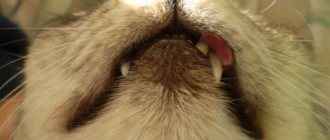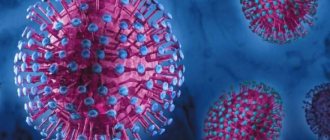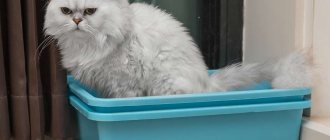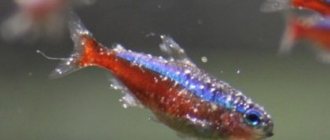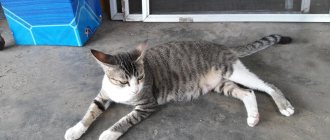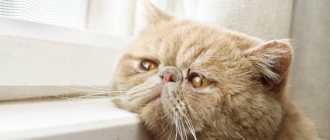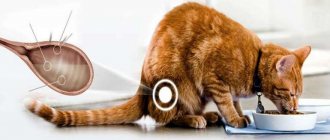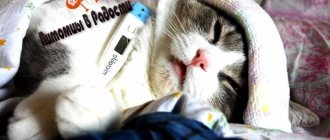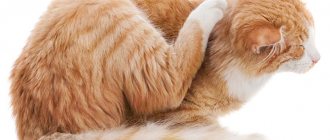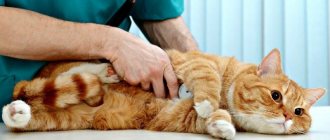A swollen and hard belly is a rather alarming symptom that accompanies many pathologies. One of them is ascites, or dropsy, which is often found in cats. It is not an independent disease and develops as a complication of pathological processes affecting the abdominal organs. To eliminate it, it is very important to determine the root cause, since relieving existing symptoms will only bring relief for a limited time.
What is abdominal ascites in cats and cats?
Normally, there is a small amount of fluid in the abdominal cavity of cats and kittens. It washes the internal organs, facilitating the movement of intestinal loops and helping the immune system. With its help, toxins and harmful microorganisms smoothly leave the body without having time to penetrate healthy cells and cause significant harm.
As a result of impaired absorption and blood circulation, the amount of fluid increases due to transudate or exudate. Unusual volume leads to increased pressure. The internal organs, shrinking, gradually lose their functionality, so without timely help the animal may die.
Clinical picture
The initial stage of the pathological condition is virtually asymptomatic, since the accumulation of fluid in the abdominal cavity is a gradual process. Characteristic signs can only be noticed when the volume of fluid exceeds normal levels. Ascites can be suspected by a noticeably swollen abdomen and stretching of the sides when the animal is active.
Symptoms:
- the abdominal cavity is swollen, hard to the touch;
- fluctuation - when pressing on the abdomen, you can feel the liquid inside it swaying;
- the belly takes on the shape of a pear when the cat stands on its hind legs, and inflates and rounds when taking a sitting position;
- dullness and disheveled fur;
- yellowish tint of mucous membranes;
- paws, ears, crotch, sternum swell;
- vomiting, nausea;
- lack of appetite;
- constipation or diarrhea;
- breathing problems, hoarseness, shortness of breath;
- weakness, apathy.
It is very important to distinguish ascites from ordinary overeating.
Causes of fluid accumulation
The risk group includes animals with congenital and acquired pathologies, which are the main causes. These include:
- Diseases of the cardiovascular system. Heart failure disrupts natural blood circulation, which causes an increase in internal pressure and increased vascular permeability.
- Abdominal injuries that provoke the development of swelling, inflammation and internal bleeding.
- Liver and kidney diseases. Disturbance in the functioning of the urinary system organs leads to acute intoxication with decay products and inflammation.
- Parasitoses and infections of various etiologies. Toxins released by pathogenic microorganisms irritate the receptors of the mucous membrane. To destroy them, the body launches an inflammatory reaction, accompanied by abundant production of exudate.
- Disturbances in the functioning of the endocrine system. Provoking factors are diabetes, excess weight and high cholesterol.
- Malignant neoplasms. Cancer cells clog lymphatic vessels, disrupting natural circulation and increasing the permeability of the walls.
Sometimes the owner is to blame for the excess amount of fluid in a cat’s stomach because he does not pay enough attention to the balance of the diet and the frequency of feedings. Complications can occur due to insufficient amounts of proteins or vitamins, as well as sodium abuse.
What are the signs of disease?
Symptoms of dropsy in a cat have characteristic features. It is very difficult not to notice and ignore the main one - a huge, swollen, swollen belly. The peritoneal area acquires a symmetrical outline, the lower part of the abdomen and its sides increase. Swelling in the tissues develops gradually, but in some conditions its signs appear extremely quickly, within a few hours. This process requires immediate consultation with a veterinarian and emergency care for your pet.
© shutterstock
If you begin to carefully feel the abdominal cavity of your furry pet, you can clearly feel the liquid under your fingers.
Additional symptoms are associated with the appearance of dropsy in the abdominal area of a cat.:
- the animal becomes lethargic, apathetic, avoids physical activity;
- his heart beats faster;
- there are signs of difficulty breathing, shortness of breath;
- there is a cough, vomiting;
- body temperature does not change;
- Along with the growth of the abdomen, a noticeable decrease in body weight occurs.
What does ascites look like in a cat: main symptoms
Dropsy in cats develops gradually and responds well to treatment in the early stages. A rapid increase in alarming symptoms and a sharp deterioration in condition are typical for pets with weakened immune systems.
One of the main signs of pathology is an enlarged abdomen. It swells and loses its elasticity. When pressing inside, you can feel the movement of water.
These symptoms are similar to ordinary overeating, so to confirm your guesses, do a small test. Lift the animal up, holding it by the armpits. With stagnation, all the contents will rush down, giving the stomach a pear-shaped shape. After placing the cat on four paws, the shape will again become round.
In addition to changes affecting the peritoneum, it is necessary to highlight several more signs:
- yellowing of mucous membranes;
- dulling of fur;
- swelling of the limbs, groin, chest and ears at the base.
All other symptoms will depend on the cause of the illness. In addition to lethargy, apathy and poor appetite, the pet may experience vomiting, stool disturbances, urinary retention, fever, shortness of breath and cough. The advanced form is accompanied by severe pain, so the mustachioed pet should be taken to an appointment at the veterinary clinic before they appear.
Symptoms
Ascites in cats can occur at a rapid pace, or it can have a sluggish form, gradually gaining momentum. The severity of symptoms and the speed of the pathological process depend on the intensity of fluid accumulation.
The main sign of the pathology is a large belly, which increases daily. The fluid accumulated in the cat's abdominal cavity distends the pet's abdomen and makes it tight. If you lift the cat under the front paws, the fluid moves to the lower part of the peritoneum and the outline of the body becomes similar to a large pear, whose sides protrude symmetrically and evenly. Swelling of the perineum is also detected.
At the beginning of the disease, transudate accumulates slowly. The volume of the cat's abdomen is small, its increase is imperceptible. Gradually, the pet becomes more and more passive, sleeps a lot, and its appetite worsens (subsequently the cat may refuse to eat at all). The abdomen increases in size. The cat suffers from constipation or diarrhea, flatulence, and vomiting.
Breathing becomes intermittent, shallow, and shortness of breath develops because the fluid presses on the chest. The cat constantly meows, tries to hide, lies on its side, moves little, gets tired quickly and collapses. During this period, an increase in body temperature is possible.
Very important! If you notice changes in behavior or a deterioration in your cat's health, even minor ones, you should immediately contact a veterinarian.
Ascites
At the veterinary clinic, your pet will undergo diagnostics, which includes:
Diagnostics in a veterinary clinic
To make a diagnosis, it is necessary to verify the presence of the suspected pathology and find out the cause of its occurrence. For this purpose, the following studies are used:
- urine analysis to determine pathologies of the urinary system;
- blood biochemistry, revealing the presence of toxins that poison the liver;
- Ultrasound confirming the presence of effusion and its exact volume, the functionality of internal organs and the presence of tumors;
- X-ray, which helps to detect the consequences of mechanical injuries and monitor the situation not only in the peritoneum, but also in the chest;
- puncture (puncture with collection of a biological sample) used to determine the composition of the fluid (exudate or transudate).
Also, the veterinarian must palpate (feel) the abdomen and collect anamnesis. After receiving the results of all studies, individual treatment is selected for the mustachioed patient.
Causes of ascites
There are cases when the cause of fluid accumulation is a banal excess of sodium in food. This disorder is treated by eliminating salt and salt-containing products from the diet, as well as diuretics under the strict supervision of a veterinarian.
Also, the cause of dropsy may be the inability to digest protein, its absence or deficiency. In this case, you just need to adjust your diet according to the recommendations of your doctor, followed by monitoring the level of protein in the body. A similar situation occurs with certain types of injuries. As a rule, once the underlying cause is eliminated, the fluid stops accumulating and the dog is completely cured.
Is hydrops of the abdominal cavity curable in cats?
For your pet to recover, the underlying disease must be eliminated. If it is diagnosed in a timely manner and can be treated, the prognosis is positive.
If the pathology is incurable or detected too late, then treatment is reduced to maintenance therapy. It helps prolong life, but does not eliminate the problem. This situation is typical in oncology, cirrhosis and advanced peritonitis.
If the cause of the disorder lies in an immune failure, then the likelihood of relapse is high. In this case, the animal will have to regularly take anti-inflammatory drugs and diuretics, and also visit a veterinarian to pump out excess transudate.
Treatment in the clinic
Treatment in a veterinary clinic differs significantly from treatment at home.
The cat's abdominal wall is punctured and the accumulated fluid is pumped out, then diuretics are given. They are very difficult to dose on your own. Uncontrolled intake can lead to the body losing a significant amount of potassium along with urine, which, in turn, will only aggravate ascites and worsen the animal’s condition due to the underlying disease.
If the help of a surgeon is needed, the cat in the clinic can have surgery much faster than if it had to be brought from home - and sometimes every minute is important to save a life!
Average price in Moscow
In Moscow clinics, examining an animal, testing and pumping out fluid will cost, on average, 5,500 rubles:
- inspection - from 450 rubles,
- tests - from 4500 rubles,
- fixing the animal - about 300 rubles,
- pumping out fluid from the abdominal cavity - from 300 rubles per hour.
The cost of further treatment depends on what diagnosis the animal was given and how severe its condition turned out to be.
Therapy methods
In addition to eliminating the root cause, treatment of abdominal ascites in cats involves relieving the main symptoms and removing accumulated fluid. In most cases, therapy is limited to taking medications, but sometimes it is necessary to resort to surgery.
Traditional drug treatment
The basis of drug treatment are diuretics (diuretics), which eliminate congestion by stimulating urination. All other drugs will depend on the diagnosis. These may include:
- analgesics necessary to suppress acute pain;
- cardiotonics that increase heart rate;
- antiemetics, weakening the gag reflex;
- potassium chloride and vitamin K, which reduce the permeability of blood vessels and strengthen their walls;
- antipyretics and sedatives;
- cephalosporin antibiotics that fight infection;
- colloidal solutions that increase the percentage of protein;
- immunomodulators that protect against secondary infection.
It is recommended to take all medications strictly as prescribed by your veterinarian. Incorrect dosage calculation or ending treatment too early can result in worsening of the condition and even death.
Drainage and surgery
Pumping out using puncture of the abdominal wall is resorted to in case of ineffectiveness of drug therapy or when there is dangerously high pressure on the internal organs. The procedure is carried out under anesthesia and repeated at least 2 times a week. This frequency and the need to use an anesthetic increases the risk of complications.
Surgery may be required if there is internal bleeding due to injury or oncology, as well as with purulent or necrotic processes. Depending on the problem, the surgeon excises pathological tissues and restores the integrity of damaged organs.
Folk remedies and help at home
The use of traditional medicine is permissible only as additional therapy and under the strict supervision of a veterinarian. Infusions and decoctions cannot eliminate the disease itself, but will alleviate its symptoms.
Self-medication using recipes found on the Internet or received from friends is unacceptable. Herbs often cause allergic reactions and are not always compatible with doctor-approved medications. Such help can result in the death of your pet, so do not try to solve the problem on your own.
If you find yourself far from the city and cannot get to a veterinary clinic in the near future, prepare an infusion of birch leaves. Pour boiling water over them in a ratio of 1:10, let it brew for 6 hours and strain. Give the resulting medicine twice a day, 1 teaspoon.
Despite the harmlessness of such an anesthetic, it is better to contact your doctor at least by phone and clarify the safety of the actions you are performing.
Nutrition correction and diet
Once the condition has stabilized, hydrops of the abdomen in cats is treated at home. In addition to taking medications, it is necessary to review your current diet:
- The amount of water and salt is kept to a minimum.
- The daily menu is adjusted in favor of meat and dairy products enriched with proteins. Twice a week, chicken, turkey or beef can be replaced with sea fish.
- The lack of vitamins and minerals is compensated by special additives to dishes.
If your pet suffers from diarrhea, then to strengthen the stool, he needs to be given rice porridge or a decoction. It is recommended to boil or steam meat and fish. This processing method will make it easier to digest.
When dry feeding, the usual food will have to be changed to veterinary food. Your doctor will help you decide on the exact brand, since a sudden switch to a new manufacturer can cause digestive upset.
Features of kitten treatment
Ascites in a kitten is treated according to general recommendations with minor differences. They consist of lower dosages and a ban on the use of immunomodulators. The first feature is explained by lower weight, and the second by the need to develop independent immunity. Taking such drugs for up to 1 year can lead to a malfunction in the immune system, resulting in the inability to distinguish healthy cells from infected ones.
Diagnosis of the disease
Making a diagnosis based only on external signs is wrong. This is why a sick cat needs to be taken to the vet. The specialist will make his verdict only after the animal has been examined and taking into account the test results. This may require:
- palpation and tapping;
- medical history (it is important that the cat owner can provide the doctor with as much information as possible about the diseases the pet has suffered);
- biological blood and urine tests;
- ultrasound examination of the abdomen;
- abdominal x-ray;
- laparoscopic examination (rarely used);
- computed tomography (practised only in elite veterinary clinics);
- fluid collection using puncture.
Examination of accumulated fluid is one of the most important measures in diagnosing ascites. Only from this material can one understand what caused the dropsy. It is a mistake to believe that water can be pumped out independently, although the intake is made through a puncture in the stomach. Firstly, the animal must be immediately given an antibiotic so that when the fluid is pumped out, an infection does not occur. And secondly, this procedure is only possible with the use of anesthesia. In order for the cat to endure the pumping itself, as well as anesthesia, such an event should be trusted only to the best veterinarian.
For diagnosis, it is necessary to at least conduct a study of ascites fluid (cytological study, PCR test for viral peritonitis).
Maria Lvovna Soloshek, veterinarian
https://www.zoovet.ru/forum/?tid=7&tem=821877
An X-ray of the abdominal cavity is needed in order to understand what abnormalities there are (increased size or incorrect position of organs, whether they are compressed, etc.)
I heard that not all veterinary clinics are equipped with special equipment (tomograph, x-ray, etc.). Many cat owners turn to several clinics at once for specific tests, and then with all the collected papers they go to their veterinary clinic. I once saw a message on some forum that a cat with ascites was abandoned. The veterinarian simply told the owner that the animal had ascites, there was no cure for it, and he would certainly die. But the owner of the poor cat did not give up on her friend, she took tests at different veterinarians, and then turned to a good specialist. The cat was cured (however, it later turned out that the first clinic simply did not have the necessary equipment).
How to distinguish it from other diseases with similar symptoms
If it becomes clear that the animal has fluid in its stomach and not something else, then this also may not only indicate ascites. For example, fluid accumulates in the abdominal cavity during exudative peritonitis. Exudative (wet) peritonitis is inflammation of the abdominal wall caused by infection. With peritonitis, ascites fluid may accumulate in the cat's abdomen, but the symptoms will vary:
- High body temperature (with ascites it is normal).
- Painful reaction to touching the belly (cats with ascites calmly respond to stroking).
- Rapid development of the disease - from 1 to 6 hours (ascites develops slowly - sometimes a week or more).
- Enlarged lymph nodes.
- Different chemical composition of the liquid.
With exudative peritonitis, the fluid contains more protein and leukocytes.
Video: how to do an ultrasound when diagnosing ascites
How to treat with medication, at the veterinarian
Drug treatment of ascites in a dog may include drugs:
- Diacarb;
- Veroshpiron;
- Furasemide;
- Dichlorothiazide;
- Losartan;
- Cordiamine;
- Sulphocamphocaine.
The required drug is selected individually, taking into account the assessment of the animal’s condition. In case of dehydration, an isotonic solution is infused. If you have breathing problems, your pet is given an oxygen mask. Blood poisoning is also possible. A transfusion will help.
It is difficult to identify the cause on your own; for this, laboratory and instrumental diagnostic methods must be used under the guidance of a competent veterinarian.
You cannot self-medicate.
